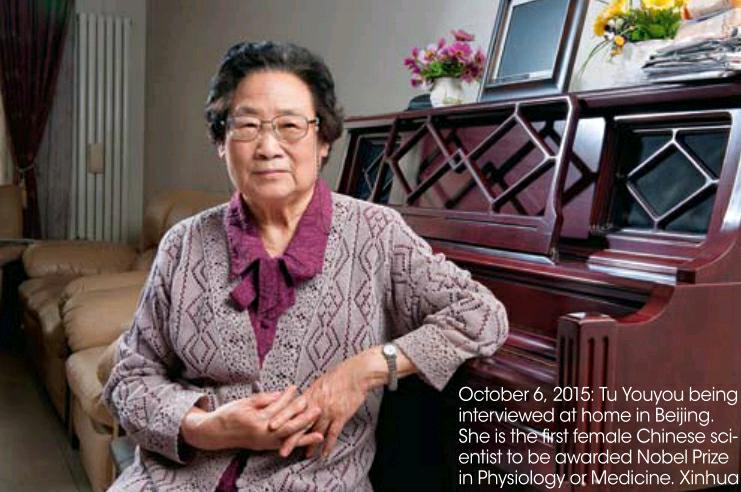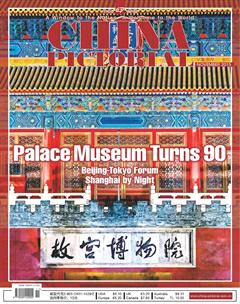Tu Youyou:“Mother of Artemisinin”
by+Wang+Yin
According to the World Malaria Report 2014 released by WTO, there were an estimated 198 million cases of malaria worldwide in 2013, and some 584,000 people died of the disease. Most of the dead were children. On October 5 this year, the Nobel Assembly at Karolinska Institute in Sweden awarded one half of the 2015 Nobel Prize in Physiology or Medicine to Tu Youyou, for her discoveries of avermectin and artemisinin as a novel therapy against malaria.
Research Starting from the Vietnam War
The official website of the US Department of Veterans Affairs records that “From 1965 to 1970, over 40,000 cases of malaria were reported in the American army in Vietnam.” From August 4, 1964, to January 27, 1973, some 3.4 million American soldiers were sent to Southeast Asia, and 40,000 cases was by no means a small figure.
Malaria, commonly called as da bai zi in South China, is a mosquito-borne infectious disease of humans and animals caused by the genus Plasmodium with symptoms that typically include periodic chills, fever, headaches, sweating, and even cerebral injury or death.
The term da bai zi (meaning “periodic chills”) vividly depicts a common symptom of malaria patients. How could people with periodic chills fight in the war? Both the US and Vietnamese armies were affected by malaria during the Vietnam War, which sharply reduced their combat effectiveness. Later, the US conducted anti-malarial research under the guidance of Walter Reed Army Institute of Research together with institutions and pharmaceutical companies in various countries, while Vietnam turned to China for help.
At that time, China was undergoing the“cultural revolution,” when most scientific research had come to a standstill. But this did not affect research on the prevention and treatment of malaria. On May 23, 1967, the General Logistics Department of the Chinese Peoples Liberation Army convened the Collaborative Conference of Researchers on Medicine for Malaria Prevention and Treatment with the National Science Committee (now Ministry of Science and Technology) and the Ministry of Health. The conference launched Mission 523, a project for the prevention of malaria and pursuit of a cure.
The project, lasting 13 years, involved an estimated two to three thousand people. In 1969, 39-year-old Tu Youyou joined Mission 523 as leader of the Professional Team of Traditional Chinese Medicine. In 1972, under her guidance, the research team extracted artemisinin. And, in 1975, with her participation, the chemical structure of artemisinin was confirmed.
The Fantastic Journey of Discovery
Ge Hong (284-364), an alchemist in the Eastern Jin Dynasty, wrote in Handbook of Prescriptions for Emergencies: Prescriptions for Chills, Fever and Malaria,“Take a handful of Artemisia annua, soak it in two liters of water, then wring the juice out and drink the extract.” According to him, drinking the extract of Artemisia annua could cure malaria. It was this document that inspired Tu Youyou.
It was hard to imagine the science research environment decades ago. Tu recalled that before their antimalarial research, quinine, the traditional antimalarial medicine, had ceased to be effective, and large quantities of infected people died. So, Tu and other researchers in Mission 523 visited practitioners of traditional medicine all over China, and based on their notes and memos, they compiled A Collection of Antimalarial Prescriptions, which, of course, included Artemisia annua.
However, in preliminary experiments, Artemisia annua did not show satisfactory results. Besides, the curative effect of the extract was not stable: There was no curative effect when boiled in water, and curative effect was only 30 to 40 percent when extracted in 95 percent ethyl alcohol. At that time, the way to deal with and take the medicine, which was spelled out in Ge Hongs book, attracted Tus attention.
“I reviewed the prescribed way for dealing with the medicine. Generally, traditional Chinese medicine was boiled in water. But why did Ge Hong choose to wring the medicine? Was it because that the active constituent was broken down under high temperature?” Tu said that while Ge Hongs prescription greatly inspired her, the prescription itself was confusing,“Ge Hong lived around 300 AD. So what was Artemisia annua at that time? Which part of this plant could be best used as medicine? Of course, the most important thing is the method of extraction.”
Thereafter, Tu lowered the temperature for extraction. She used diethyl ether, which had a relatively low boiling point, and obtained active extract from Artemisia annua under 60 degrees Celsius. And, the inhibition ratio of this extract against Plasmodium reached 100 percent.
In March 1972, at a review conference on Mission 523, Tu Youyou released reports of related research and clinical experiments. Later, Zhong Yurong, a member in Tus team, successfully acquired the crystal of the active contract, which was later named “Artemisinin.” After Tu announced the research status, project teams in Shandong and Yunnan extracted effective antimalarial substances from other categories of Artemisia annua in succession. In early 1974, Beijings artemisinin and its counterparts in Shandong and Yunnan were identified as the same medicine, which later became the artemisinin that saved hundreds of millions from malaria.

The Nobel Assembly wrote, “Youyou Tu in China turned to traditional herbal medicine to tackle the challenge of de- veloping novel malaria therapies... so Tu revisited the ancient literature and discovered clues that guided her in her quest to successfully extract the active component from Artemisia annua… later called artemisinin… Artemisinin represents a new class of antimalarial agents that rapidly kill the malaria parasites at an early stage of their development, which explains its unprecedented potency in the treatment of severe malaria.”
As a Chinese scientist who discovered something new in the treasure-house of traditional Chinese medicine and has been recognized by the international scientific community, 85-year-old Tu Youyou felt quite proud. “In my childhood, I witnessed the scenes of sickness cured and patients saved via traditional Chinese medicine. But I had never imagined that the relationship between my life and this magical herbal medicine would be so close. Artemisinin is a gift of traditional Chinese medicine to the whole world. The success is due to the hard work and devotion of the whole research team, and the award is an honor to all Chinese scientists.”

